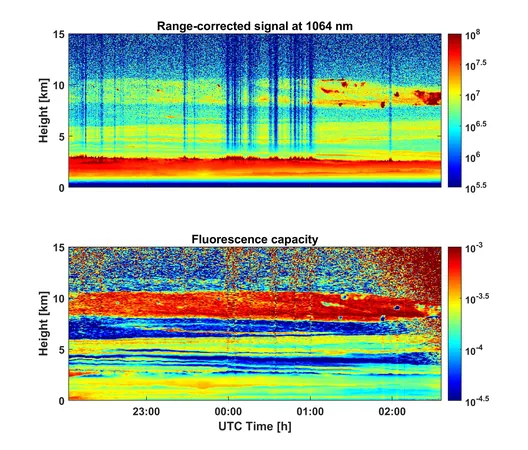
Unlocking the Secrets of High-Altitude Smoke: Groundbreaking Lidar Technology Reveals Hidden Dangers
2025-06-04
Author: Arjun
A Revolutionary Discovery in Atmospheric Research
A cutting-edge fluorescence lidar technology is changing the way scientists understand the Earth's atmosphere. A dedicated team from the Leibniz Institute for Tropospheric Research (TROPOS) has employed this innovative method to unveil particle layers in the atmosphere that were previously invisible. Their remarkable findings, based on an extensive evaluation of 250 hours of lidar measurements conducted over Leipzig between 2022 and 2023, have been published in the esteemed journal Atmospheric Chemistry and Physics.
High-Altitude Smoke: A Hidden Threat
During their research, the scientists discovered thin layers of smoke floating high above Europe, primarily originating from devastating forest fires in Canada. These layers, undetectable by conventional methods, suggest that the upper troposphere over Europe might be more polluted than previously believed, particularly during the summer months.
Smoke's Role in Cloud Formation: A New Perspective
These findings also indicate that such smoke layers could influence cloud formation, particularly ice clouds, thereby altering local weather patterns. The fluorescence method not only enhances the identification of aerosol types but also highlights the vital interactions between aerosols and clouds.
Advanced Technology in Action: MARTHA Lidar System
At the heart of this breakthrough is MARTHA (Multiwavelength Atmospheric Raman Lidar for Temperature, Humidity, and Aerosol Profiling), a sophisticated lidar system at TROPOS. Emitting laser light across multiple wavelengths, this system captures and analyzes the backscattered light to differentiate particle types based on their scattering behavior.
Identifying Invisible Aerosols
While the lidar technology provides a wealth of information, precisely distinguishing between smoke, volcanic sulfates, and urban pollution in various atmospheric layers remains challenging. However, the introduction of fluorescence allows researchers to identify aerosol structures that were previously overlooked.
A Profound Impact on Climate Understanding
As the research progressed, particularly during the significant wildfires across Canada in the summer of 2023, the MARTHA system detected vast smoke layers over Leipzig, revealing strong fluorescence signals on particular nights. The researchers noted a more than 2-kilometer thick layer of smoke, showcasing how groundbreaking technology can uncover previously invisible environmental issues.
Future Prospects: Enhancing the Lives of Scientific Communities
As scientists continue to refine their understanding of the interplay between aerosols and cloud formation, the new measurements signal a shift in how atmospheric pollution is perceived. With ongoing upgrades to the MARTHA system, including a more powerful laser and advanced spectrometer, more precise measurements are on the horizon.
Conclusion: A Call for Further Research
This pioneering research highlights the importance of fluorescence lidar technology in environmental science, offering clues about the complex relationships between smoke particles, cloud formation, and climate change. As more data accumulates, it could enhance our understanding of how forest fire smoke influences weather patterns and climate, asserting the need for continued exploration of these atmospheric phenomena.



 Brasil (PT)
Brasil (PT)
 Canada (EN)
Canada (EN)
 Chile (ES)
Chile (ES)
 Česko (CS)
Česko (CS)
 대한민국 (KO)
대한민국 (KO)
 España (ES)
España (ES)
 France (FR)
France (FR)
 Hong Kong (EN)
Hong Kong (EN)
 Italia (IT)
Italia (IT)
 日本 (JA)
日本 (JA)
 Magyarország (HU)
Magyarország (HU)
 Norge (NO)
Norge (NO)
 Polska (PL)
Polska (PL)
 Schweiz (DE)
Schweiz (DE)
 Singapore (EN)
Singapore (EN)
 Sverige (SV)
Sverige (SV)
 Suomi (FI)
Suomi (FI)
 Türkiye (TR)
Türkiye (TR)
 الإمارات العربية المتحدة (AR)
الإمارات العربية المتحدة (AR)